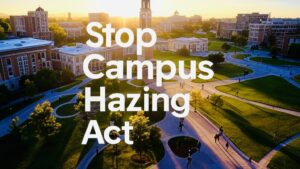The Stop Campus Hazing Act represents a significant step forward in the fight against hazing on college campuses
 The first substantive requirement of the Stop Campus Hazing Act (Public Law No. 118-173) takes effect today, January 1, 2025, when the collection of hazing statistics begins. This is the first new crime added to the Clery Act’s statistics in 11 years, with the last addition being “VAWA offenses” in 2014.
The first substantive requirement of the Stop Campus Hazing Act (Public Law No. 118-173) takes effect today, January 1, 2025, when the collection of hazing statistics begins. This is the first new crime added to the Clery Act’s statistics in 11 years, with the last addition being “VAWA offenses” in 2014.
Comprehensive, Inclusive Definitions
The Act, passed by both houses of Congress and signed by the President on December 23, 2024, provides a detailed definition of hazing (included below) as well as a counting rule that is similar to how robberies are tallied. Specifically “if the same person or persons commit more than one hazing act, and the time and place intervals separating each such act are insignificant, such acts shall be reported as a single hazing incident.”
With the intention of capturing as much information as possible about hazing the definition of “student organization” is broader than the existing “student organization recognized by the institution” criteria used to determine if a location is included in the reporting of crime statistics. The Act specifically includes groups “whether or not the organization is established or recognized by the institution.”
Jeanne Clery Campus Safety Act

The Act also renames the Clery Act as the “Jeanne Clery Campus Safety Act”, a provision that took effect immediately upon enactment of the law on December 23, 2024. This is intended to reflect the comprehensive multidisciplinary campus safety focus of the law today. The adoption of this change was requested by SAFE Campuses, LLC and the Clery Center, the organization founded by Jeanne Clery’s parents Connie and Howard.
SAFE Campuses looks forward to working with our partners across higher education to realize the full potential of this new law to better prevent the deadly threat of hazing.
Hazing Definition
“(vi) The term ‘hazing’, for purposes of reporting statistics on hazing incidents under paragraph (1)(F)(iv), means any intentional, knowing, or reckless act committed by a person (whether individually or in concert with other persons) against another person or persons regardless of the willingness of such other person or persons to participate, that—
“(I) is committed in the course of an initiation into, an affiliation with, or the maintenance of membership in, a student organization; and
“(II) causes or creates a risk, above the reasonable risk encountered in the course of participation in the institution of higher education or the organization (such as the physical preparation necessary for participation in an athletic team), of physical or psychological injury including—
“(aa) whipping, beating, striking, electronic shocking, placing of a harmful substance on someone’s body, or similar activity;
“(bb) causing, coercing, or otherwise inducing sleep deprivation, exposure to the elements, confinement in a small space, extreme calisthenics, or other similar activity;
“(cc) causing, coercing, or otherwise inducing another person to consume food, liquid, alcohol, drugs, or other substances;
“(dd) causing, coercing, or otherwise inducing another person to perform sexual acts;
“(ee) any activity that places another person in reasonable fear of bodily harm through the use of threatening words or conduct;
“(ff) any activity against another person that includes a criminal violation of local, State, Tribal, or Federal law; and
“(gg) any activity that induces, causes, or requires another person to perform a duty or task that involves a criminal violation of local, State, Tribal, or Federal law.”.
Student Organization Definition
“(vii) The term ‘student organization’, for purposes of reporting under paragraph (1)(F)(iv) and paragraph (9)(A), means an organization at an institution of higher education (such as a club, society, association, varsity or junior varsity athletic team, club sports team, fraternity, sorority, band, or student government) in which two or more of the members are students enrolled at the institution of higher education, whether or not the organization is established or recognized by the institution.”.
